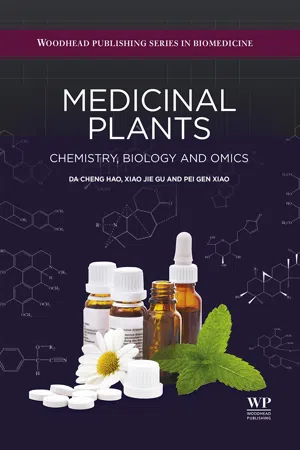
- 694 pages
- English
- ePUB (mobile friendly)
- Available on iOS & Android
About This Book
Medicinal Plants: Chemistry, Biology and Omics reviews the phytochemistry, chemotaxonomy, molecular biology, and phylogeny of selected medicinal plant tribes and genera, and their relevance to drug efficacy.
Medicinal plants provide a myriad of pharmaceutically active components, which have been commonly used in traditional Chinese medicine and worldwide for thousands of years. Increasing interest in plant-based medicinal resources has led to additional discoveries of many novel compounds, in various angiosperm and gymnosperm species, and investigations on their chemotaxonomy, molecular phylogeny and pharmacology.
Chapters in this book explore the interrelationship within traditional Chinese medicinal plant groups and between Chinese species and species outside of China. Chapters also discuss the incongruence between chemotaxonomy and molecular phylogeny, concluding with chapters on systems biology and "-omics" technologies (genomics, transcriptomics, proteomics, and metabolomics), and how they will play an increasingly important role in future pharmaceutical research.
- Reviews best practice and essential developments in medicinal plant chemistry and biology
- Discusses the principles and applications of various techniques used to discover medicinal compounds
- Explores the analysis and classification of novel plant-based medicinal compounds
- Includes case studies on pharmaphylogeny
- Compares and integrates traditional knowledge and current perception of worldwide medicinal plants
Frequently asked questions
Information
Chemotaxonomy
a phylogeny-based approach
Abstract
1.1 Introduction
1.2 Chemotaxonomic marker
1.2.1 Primary metabolite
1.2.1.1 Fatty acid


| Species | Acteoside | Paraboside B | Isonuomioside A | Paraboside II | Paraboside III |
| Beccarinda tonkinensis | * | _ | _ | _ | _ |
| Hemiboea subcapitata | * | _ | _ | _ | _ |
| Hemiboea flaccida | * | _ | * | _ | _ |
| Chirita macrodonta | * | _ | _ | _ | _ |
| Chirita pumila | * | _ | _... |
Table of contents
- Cover image
- Title page
- Table of Contents
- Copyright
- Preface
- 1: Chemotaxonomy: a phylogeny-based approach
- 2: High-throughput sequencing in medicinal plant transcriptome studies
- 3: Taxus medicinal resources: a comprehensive study
- 4: Phytochemical and biological research of Fritillaria medicinal resources
- 5: Phytochemical and biological research of Chelidonieae pharmaceutical resources
- 6: Phytochemical and biological research of Papaver pharmaceutical resources
- 7: Chemical and biological studies of Aconitum pharmaceutical resources
- 8: Chemical and biological studies of Cimicifugeae pharmaceutical resources
- 9: Chemical and biological research of Clematis medicinal resources
- 10: Potentilla and Rubus medicinal plants: potential non-Camellia tea resources
- 11: Phytochemical and biological research of Cannabis pharmaceutical resources
- 12: Phytochemical and biological research of Polygoneae medicinal resources
- 13: Phytochemistry and biology of Ilex pharmaceutical resources
- 14: Phytochemical and biological research of Salvia medicinal resources
- 15: Phytochemical and biological research of Panax medicinal resources
- Index